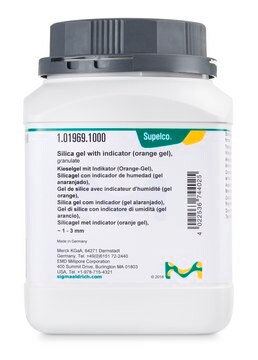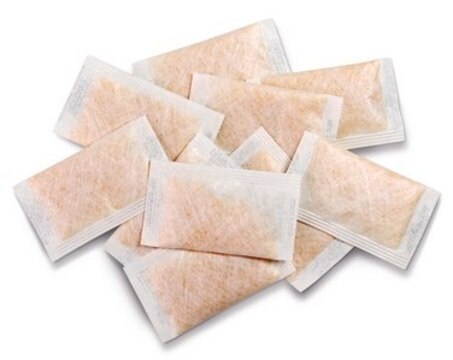94098
Trockenperlen Orange
Synonym(e):
Aluminiumsilikat, Silicagel orange
Anmeldenzur Ansicht organisationsspezifischer und vertraglich vereinbarter Preise
Alle Fotos(1)
About This Item
Empfohlene Produkte
Beschreibung
heavy metal free
Qualitätsniveau
Form
beads
Kapazität
>30 % absorption capacity (water)(at 80% rel. humidity, 25°C)
Allgemeine Beschreibung
Trocknungsperlen Orange (Kieselgel Orange) werden verbreitet als Trocknungsmittel in Laboren eingesetzt und eignen sich zum Trocknen aller Gase und Feststoffe. Sie werden in Exsikkatoren, Trockentürmen und Absorptionsröhrchen eingesetzt. Kieselgel Orange kann aufgrund seiner größeren Oberfläche, die eine hohe Absorptionskapazität ermöglicht, länger gelagert werden. Nach der Aufnahme von Feuchtigkeit (eine Beladung mit einem Gewichtsanteil von etwa 6 %) ändert es außerdem seine Farbe von orange zu farblos.
Rekonstituierung
Regeneration durch Trocknung bei 130–160 °C; nicht über 160 °C erhitzen
Lagerklassenschlüssel
13 - Non Combustible Solids
WGK
nwg
Flammpunkt (°F)
Not applicable
Flammpunkt (°C)
Not applicable
Persönliche Schutzausrüstung
Eyeshields, Gloves, type N95 (US)
Hier finden Sie alle aktuellen Versionen:
Besitzen Sie dieses Produkt bereits?
In der Dokumentenbibliothek finden Sie die Dokumentation zu den Produkten, die Sie kürzlich erworben haben.
Kunden haben sich ebenfalls angesehen
Jamieson K Christie et al.
The journal of physical chemistry. B, 116(41), 12614-12620 (2012-09-18)
The low solubility (high durability) of yttrium aluminosilicate (YAS) glass is one of its most important properties for use in in situ radiotherapy. Simple parameters, such as silica or yttria content or network connectivity, are not sufficient to rationalize the
Mariaimmacolata Preianò et al.
Proteomics, 12(22), 3286-3294 (2012-09-22)
Herein we report the use of mesoporous aluminosilicate (MPAS) for the simultaneous extraction of peptides and lipids from complex body fluids such as human plasma and synovial fluid. We show that MPAS particles, given their mesostructural features with nanometric pore
Jin-Kyu Kang et al.
Environmental technology, 34(5-8), 703-710 (2013-07-11)
The aim of this study was to investigate the adhesion of bacteria (Escherichia coli) to pyrophyllite clay using batch and flow-through column experiments. Batch results demonstrated that pyrophyllite was effective in removing bacteria (94.5 +/- 2.0%) from aqueous solution (1
G Ipek Yucelen et al.
Nano letters, 12(2), 827-832 (2012-01-25)
We demonstrate new molecular-level concepts for constructing nanoscopic metal oxide objects. First, the diameters of metal oxide nanotubes are shaped with angstrom-level precision by controlling the shape of nanometer-scale precursors. Second, we measure (at the molecular level) the subtle relationships
Benjamin J Smith et al.
Proceedings of the National Academy of Sciences of the United States of America, 108(22), 8949-8954 (2011-05-13)
Sugar molecules adsorbed at hydrated inorganic oxide surfaces occur ubiquitously in nature and in technologically important materials and processes, including marine biomineralization, cement hydration, corrosion inhibition, bioadhesion, and bone resorption. Among these examples, surprisingly diverse hydration behaviors are observed for
Unser Team von Wissenschaftlern verfügt über Erfahrung in allen Forschungsbereichen einschließlich Life Science, Materialwissenschaften, chemischer Synthese, Chromatographie, Analytik und vielen mehr..
Setzen Sie sich mit dem technischen Dienst in Verbindung.



